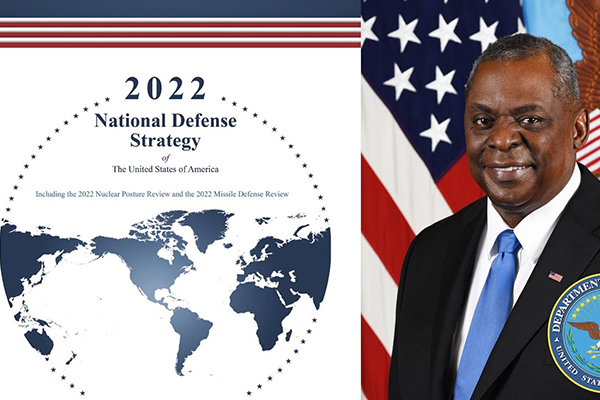The US has identified China as its “most consequential strategic competitor for the coming decades” whose “coercive tactics” are the most comprehensive and a serious challenge to U.S. national security.
The National Defense Strategy of the United States of America, released late 27 October by defence secretary Llyod Austin, directed the Department of Defense “to act urgently” to sustain and strengthen U.S. deterrence, with the People’s Republic of China (PRC) as the department’s “pacing challenge”.
However, it noted that “conflict with the PRC is neither inevitable nor desirable”.
It also identified Russia as an “acute threat” and said that the United States and its allies and partners will increasingly face the challenge of deterring two major powers with modern and diverse nuclear capabilities — the PRC and Russia — creating new stresses on strategic stability.
Making a clear shift from the terror angle to homeland threat, the defence strategy paper, which acts as the guiding principles for the US defence department, said the scope and scale of threats to the homeland (US) have fundamentally changed.
The PRC and Russia now pose more dangerous challenges to safety and security at home, even as terrorist threats persist, it said.
India and its tensions with China along the Line of Actual Control (LAC) figured thrice in the 80-page document which said that the department will advance “our Major Defense Partnership with India to enhance its ability to deter PRC aggression and ensure free and open access to the Indian Ocean region”.
It also noted that the department will also support ally and partner efforts, in accordance with U.S. policy and international law, to address acute forms of gray zone coercion from the PRC’s campaigns to establish control over the East China Sea, Taiwan Strait, South China Sea, and disputed land borders, such as with India.
At the same time, the department will continue to prioritise maintaining open lines of communication with China’s People’s Liberation Army (PLA) and managing competition responsibly, it said.
Noting that the US 2022 National Security Strategy released earlier this month observes that the PRC is “the only country with both the intent to reshape the international order, and, increasingly, the economic, diplomatic, military, and technological power to do so”, Austin said China remains our most consequential strategic competitor for the coming decades.
“I have reached this conclusion based on the PRC’s increasingly coercive actions to reshape the Indo-Pacific region and the international system to fit its authoritarian preferences, alongside a keen awareness of the PRC’s clearly stated intentions and the rapid modernisation and expansion of its military,” Austin said.
‘Part of broader destabilising, coercive PRC behavior’
The PRC seeks to undermine U.S. alliances and security partnerships in the Indo-Pacific region, and leverage its growing capabilities, including its economic influence and the the PLA’s growing strength and military footprint, to coerce its neighbors and threaten their interests, stated the defence strategy document.
The PRC’s increasingly provocative rhetoric and coercive activity towards Taiwan are destabilising, risk miscalculation, and threaten the peace and stability of the Taiwan Strait, it added.
“This is part of a broader pattern of destabilizing and coercive PRC behavior that stretches across the East China Sea, the South China Sea, and along the Line of Actual Control,” said the document.
Noting that the PRC has expanded and modernised nearly every aspect of the PLA, with a focus on offsetting U.S. military advantages, the document concluded that PRC is therefore the “pacing challenge” for the department.
It added that in addition to expanding its conventional forces, the PLA is rapidly advancing and integrating its space, counterspace, cyber, electronic, and informational warfare capabilities to support its holistic approach to joint warfare.
“The PLA seeks to target the ability of the (US) Joint Force to project power to defend vital U.S. interests and aid our Allies in a crisis or conflict,” said the document.
It added: “The PRC is also expanding the PLA’s global footprint and working to establish a more robust overseas and basing infrastructure to allow it to project military power at greater distances. In parallel, the PRC is accelerating the modernization and expansion of its nuclear capabilities.”













